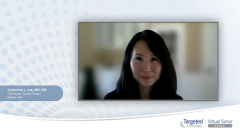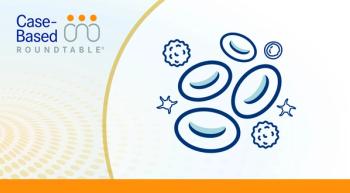
Current GVHD Prophylaxis Strategies
Yi-Bin Chen leads the panel in a review of various GVHD prophylaxis regimens.
Episodes in this series

Transcript:
Yi-Bin Chen, MD: Every recipient undergoing allogeneic transplant will receive some prevention against graft-vs-host disease [GVHD]. Several platforms have been used. Over the last few decades, the most common platform has been a calcineurin inhibitor, either a cyclosporine or tacrolimus, paired with an antimetabolite. That was developed with short doses of methotrexate given in the first week or 2 after transplant. Other centers moved to pair it with mycophenolate, which can be given orally. Others paired calcineurin inhibitors with the mTOR inhibitor sirolimus, combining it with methotrexate.
Throughout the years, there have been a lot of anti-T cell antibodies. Several products that we use are labeled ATG [anti-thymocyte globulin]. We probably shouldn’t call them all ATG, but we tend to because they’re all different biological products with different polyclonal properties. But ATG or ATG-F [anti-thymocyte globulin Fresenius] is an approved product in Europe to prevent chronic graft-vs-host disease. Yet the trials to confirm that in North America didn’t show overall benefit. It’s interesting to see the regional differences in practice, even from center to center.
Outside the calcineurin inhibitor backbone, there’s the emerging regimen of post-transplant high-dose cyclophosphamide. This was innovated by our colleagues at Johns Hopkins. It was first developed for use in mismatched donors and making its way into conventional transplant. Outside using drugs in general, there are the graft manipulation strategies that we’ve tended to call T-cell depletion but are far more complex than that. They’re based on whether you’re using positive or negative selection or the new methods of graft selection, which have been able to separate the grafts into different lymphocyte subsets and curate a graft based on that. Modern trials are trying to figure this out. We’ve started doing trials comparing each platform with the other to try to get answers. There are other trials studying graft manipulation strategies. It’s an exciting time.
I’d like to ask my colleagues, what prophylaxis regimens do you all typically use in your institutions? I’m going to start with Colleen, who works with me at Mass General. Colleen, what do we typically use at Mass General for GVHD prophylaxis?
Colleen Danielson, NP: We see increases in using post-transplant Cytoxan. We use a lot of tacrolimus with methotrexate in the hospital. We have combinations of tacrolimus using cell septum as well. But post-transplant Cytoxan is probably the newest thing that’s been exciting, initially used for haploidentical transplants and now used more frequently.
Yi-Bin Chen, MD: Corey, has there been a recent shift in your institution [Dana-Farber Cancer Institute] for how you prevent graft-vs-host disease?
Corey S. Cutler, MD, MPH, FRCPC: In the reduced-intensity setting, we’ve shifted to the post-transplant cyclophosphamide regimen based on randomized data. In the myeloablative setting, we still use a fair bit of tacrolimus and methotrexate. The first compound to be FDA approved for the prevention of acute GVHD, abatacept, is used somewhat regularly in donors with 7 of 8 mismatched donors for transplantation. We tend not to use it in reduced-intensity transplant, but in the ablative setting we’ll use it, particularly in the mismatched patient. The other thing is that we’re all continually trying to improve the regimens we have. Any time we have a clinical trial available for a novel method of prevention of GVHD, that’s often our first choice.
Yi-Bin Chen, MD: Those are exciting developments. The randomized data from BMT CTN 1703 show superiority of post-transplant cyclophosphamide and reduced-intensity, well-matched donors. Abatacept, which is used in combination with tacrolimus-methotrexate in a myeloablative setting, is a step forward. We’re trying to figure out how to incorporate that. Catherine, what do you use in Seattle? Maybe you’d like to tell us what you used to use in Utah.
Catherine J. Lee, MD, MS: I just joined Hutch [Fred Hutchinson Cancer Center], so I’m becoming familiar with what’s being used. There’s a priority for clinical trials, and there are multiple clinical trials evaluating different types of prophylaxis regimens. But I also believe we use post-transplant cyclophosphamide since the results from BMT CTN 1703 have come out, especially in the … sensitive transplant setting. This was also true at the Huntsman Cancer Center in Salt Lake City, Utah. Prior to BMT CTN 1703, we were using the historical calcineurin, urine, and mini methotrexate-based GVHD prophylaxis. It’s still used for ablative regimens, although there are more data coming out showing that post-transplant cyclophosphamide seems to have efficacy and appears safe in the ablative settings. We look forward to seeing whether there will be any control data or randomized data evaluating post-transplant cyclophosphamide in the ablative setting.
Yi-Bin Chen, MD: The results of those trials are eagerly awaited. There are other large trials ongoing, such as those using alpha-1 antitrypsin. I was fortunate enough to present exciting data using vedolizumab. There’s another ongoing trial looking at a longer course of abatacept to see if it can help with chronic graft-vs-host disease. Those are all excellent efforts going forward. Corey, there’s another phase 3 trial using a cell-manipulated graft from … Orca that seems to have a proprietary cell-sorting technology where they’re able to separate regulatory and conventional T cells and create a custom graft in that way. Most of their results are single center from working with our colleagues at Stanford, but they look great. What’s your view on the future of that type of technology going forward knowing where the pharmacological field is?
Corey S. Cutler, MD, MPH, FRCPC: The technology you referred to is exciting. They’re engaged in a randomized phase 3 clinical trial. It’s not blinded, but it’s a phase 3 trial, which is the gold standard if we want to define that as a standard. I view the technology as essentially a T-cell depletion-type strategy. You’re dialing down the number of conventional or effector T cells in the graft and perhaps enriching regulatory T cells. I’m a little concerned about what the pharmacoeconomics are going to be at the end of the day, but that’s not our concern. Our concern is making sure our patients have the best outcomes from transplantation. The field of pharmacologic prevention has advanced nicely that these pan–T-cell-depletion strategies probably won’t need to be considered in the future. But until we see the results of the randomized data and consider cost-effectiveness, we won’t know. It’s an exciting advance in the field.
Yi-Bin Chen, MD: I agree. We all await the results of these studies.
Transcript edited for clarity.














































